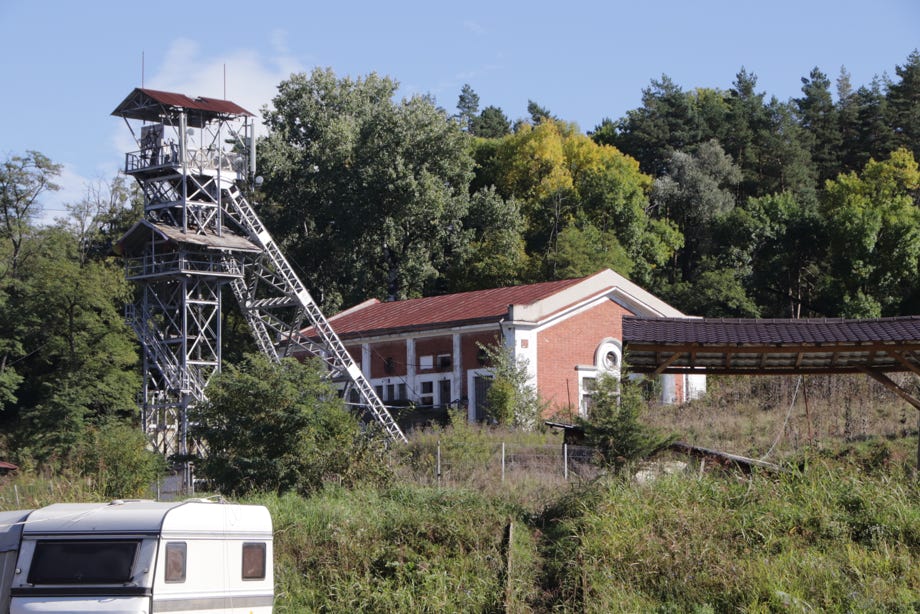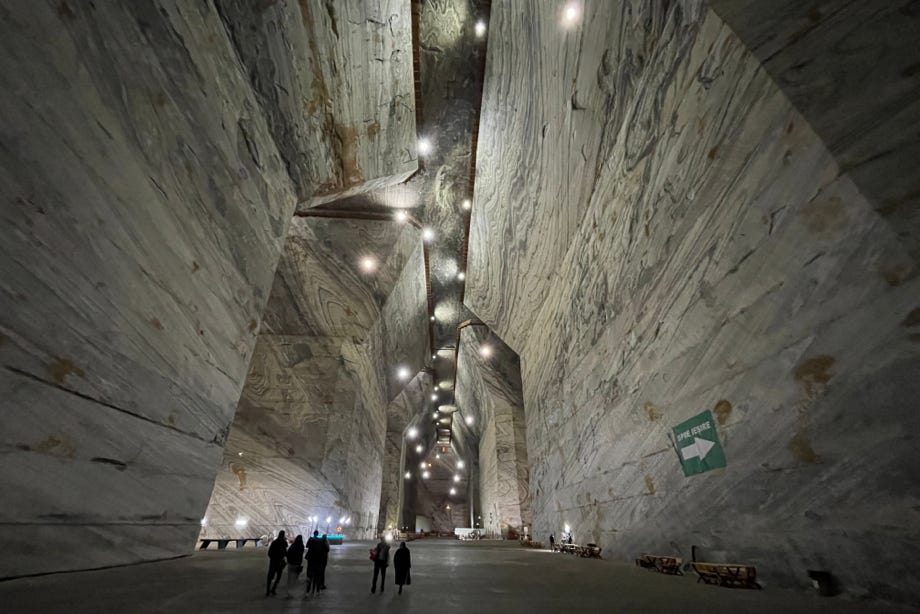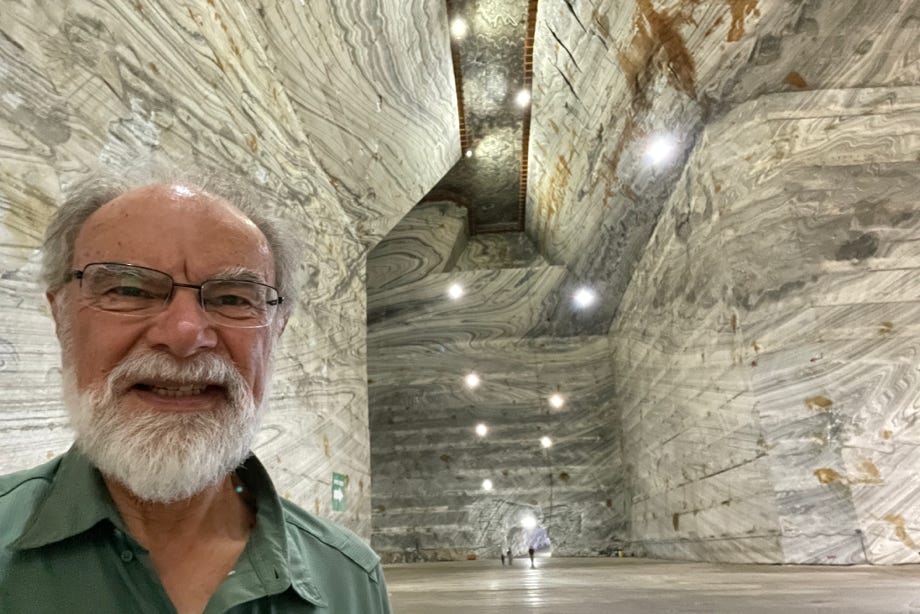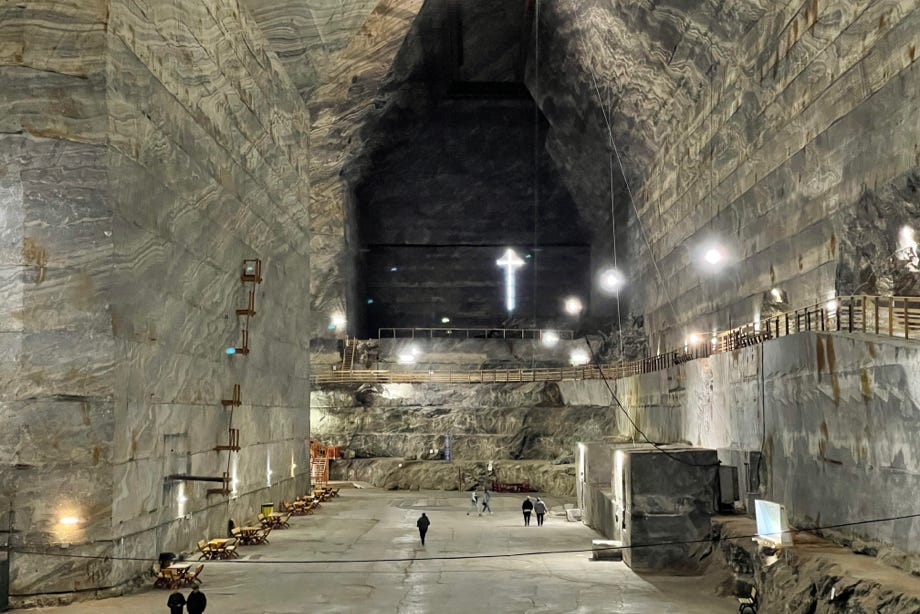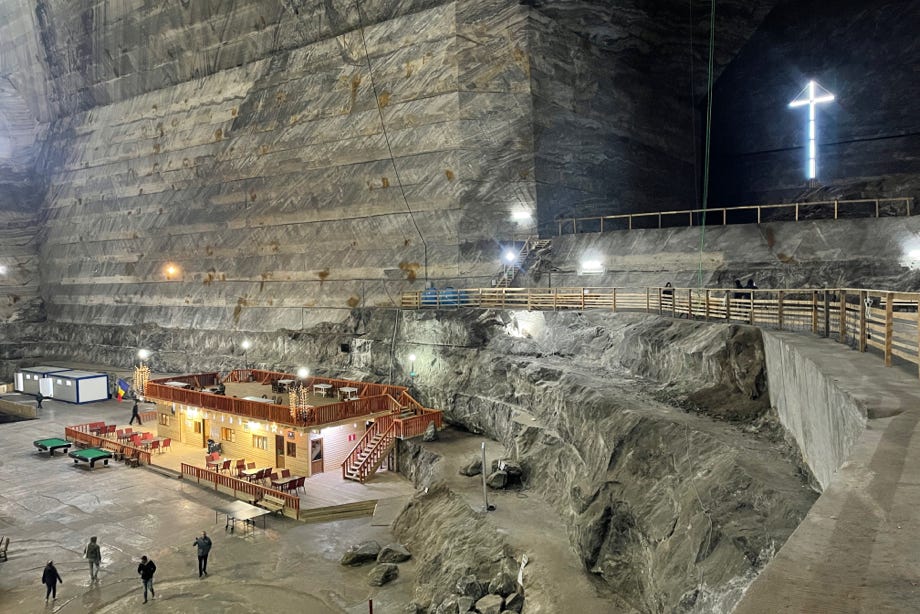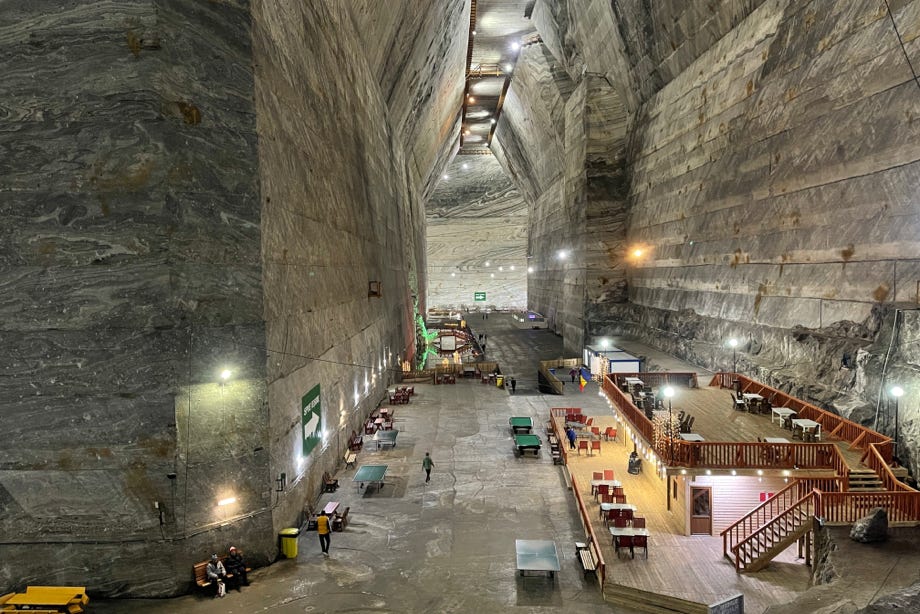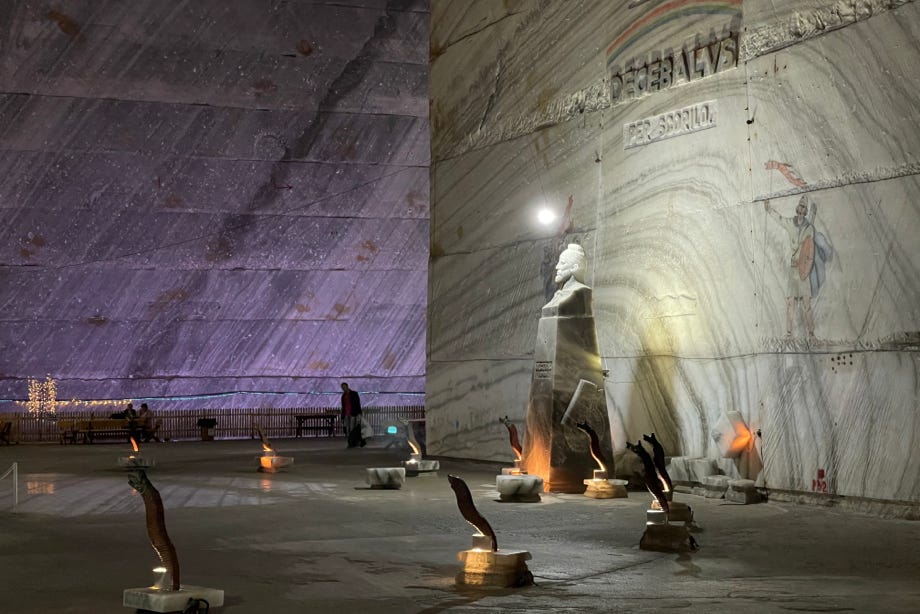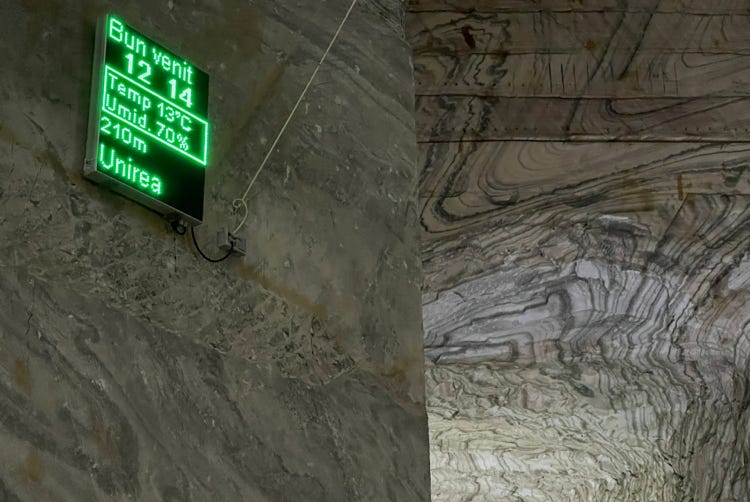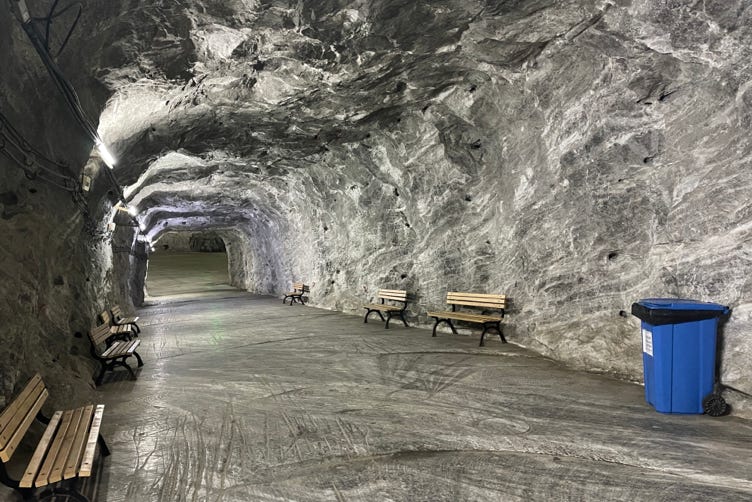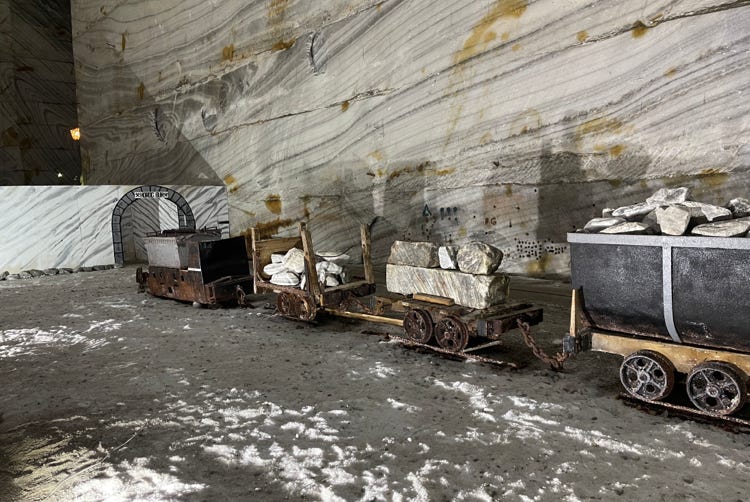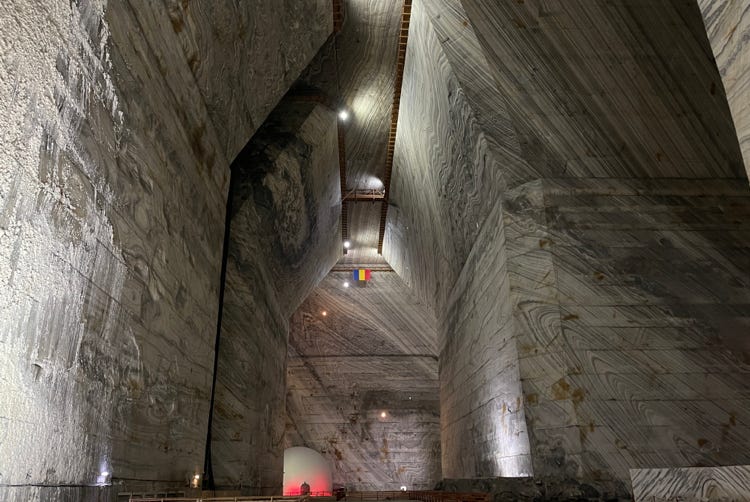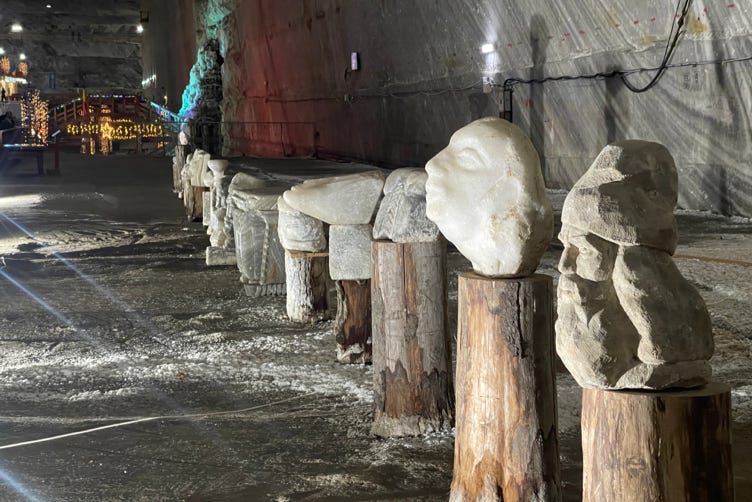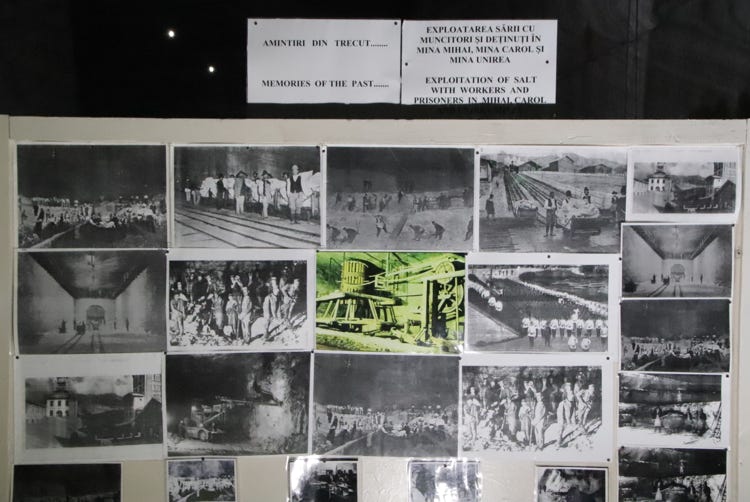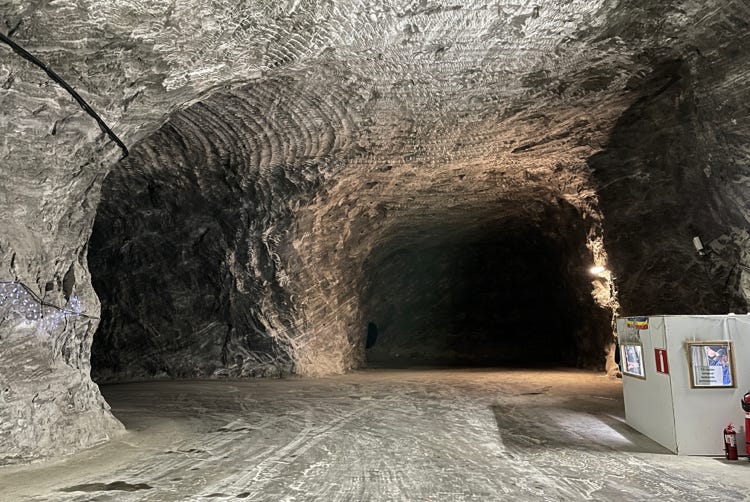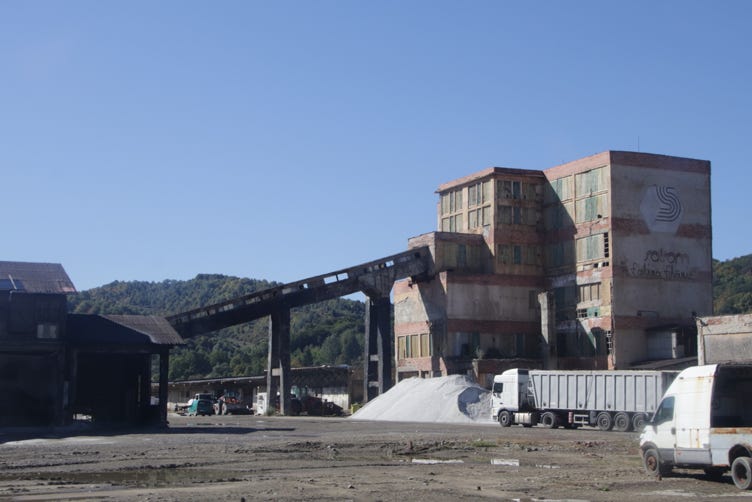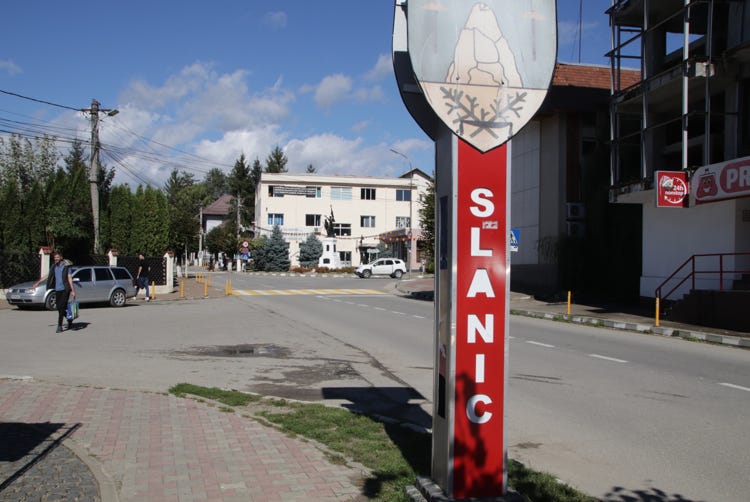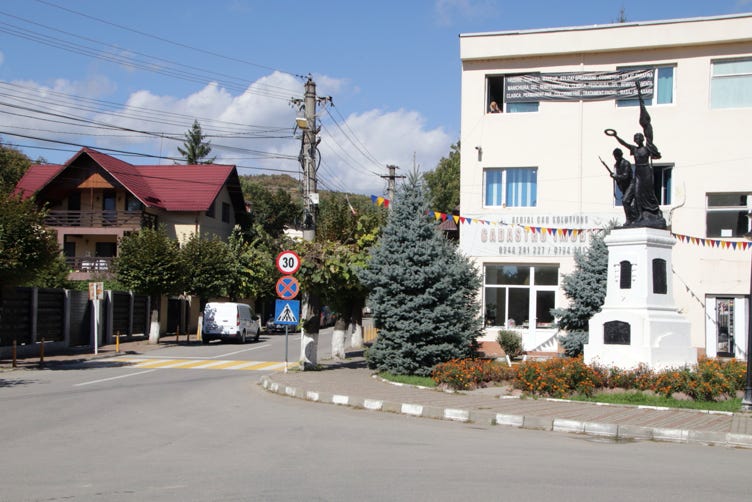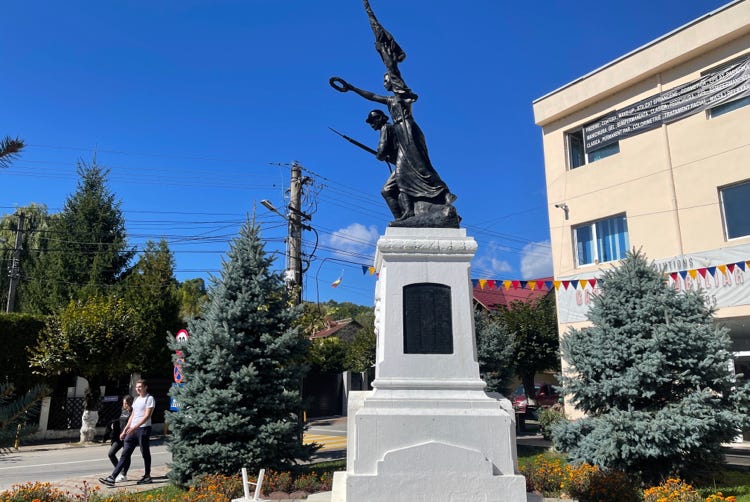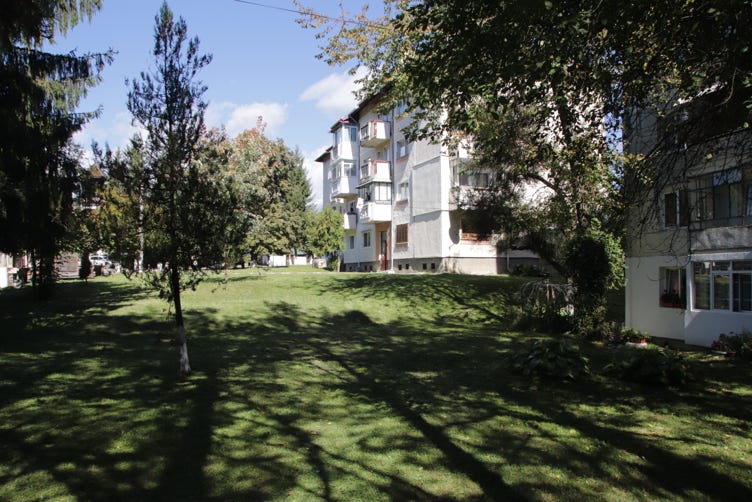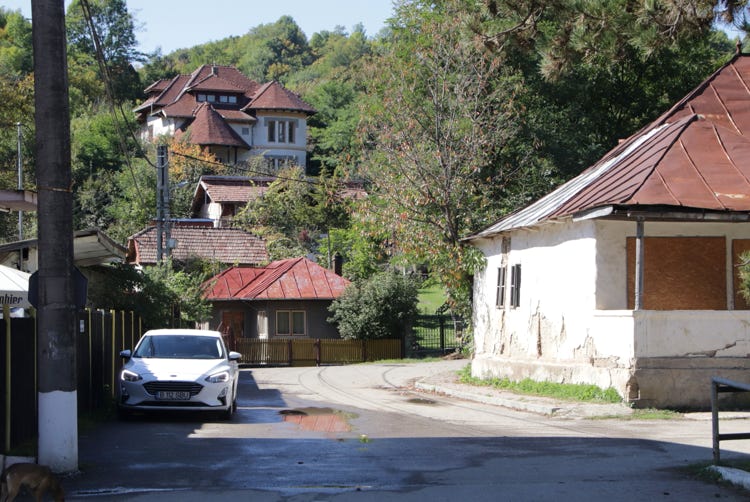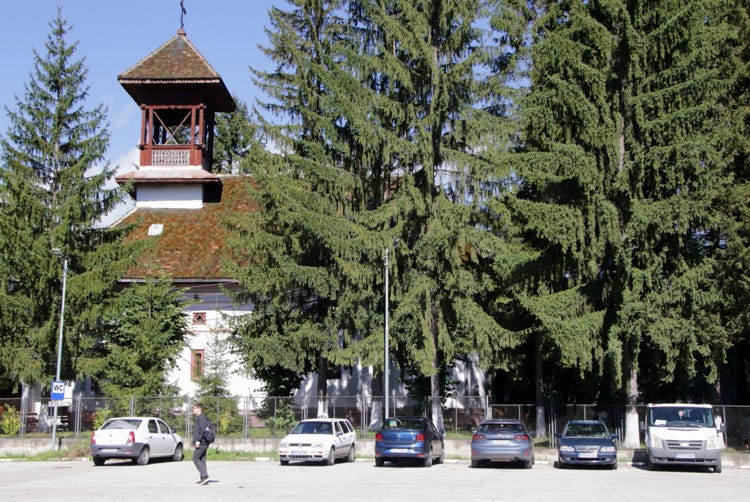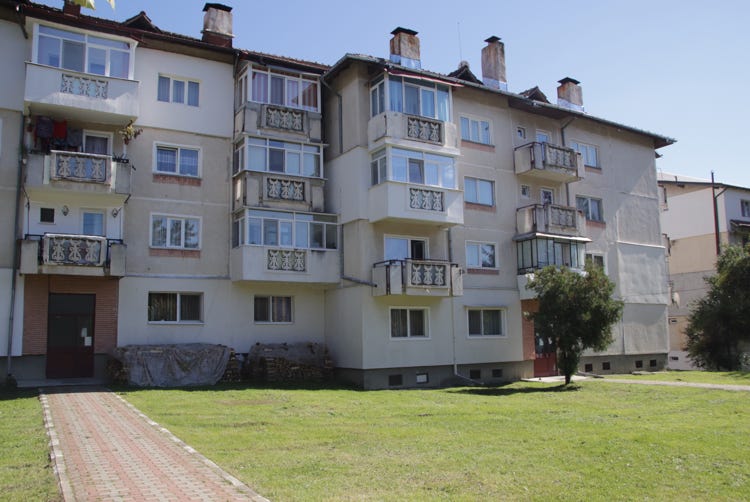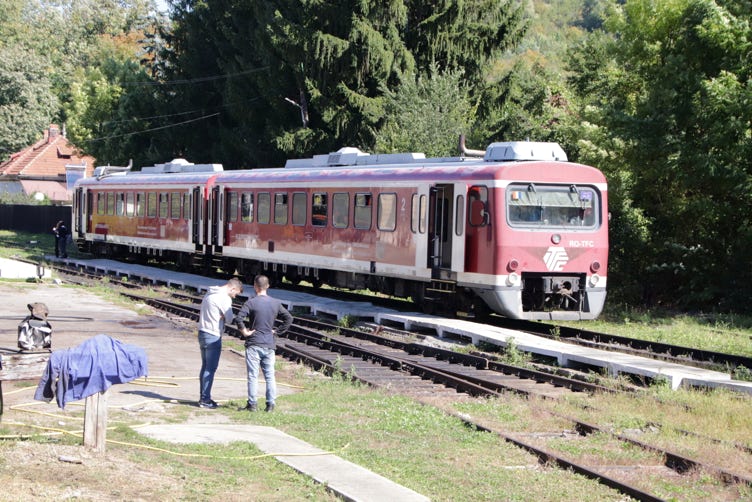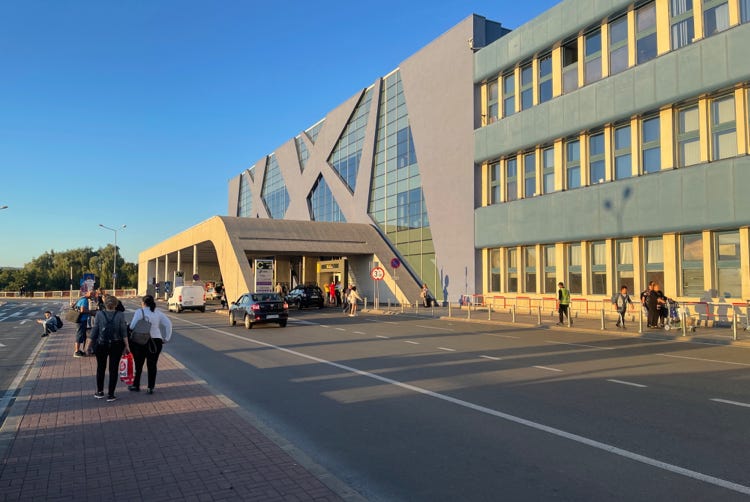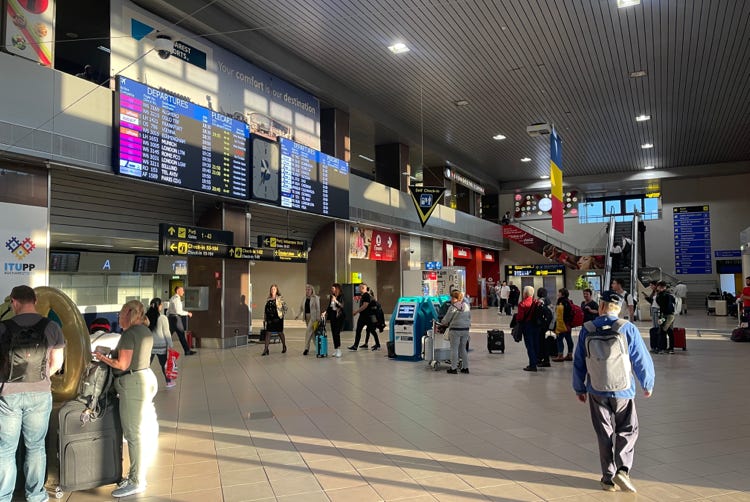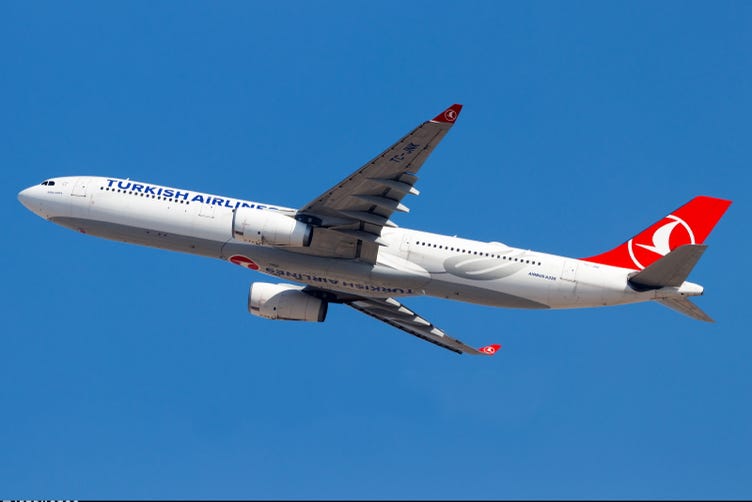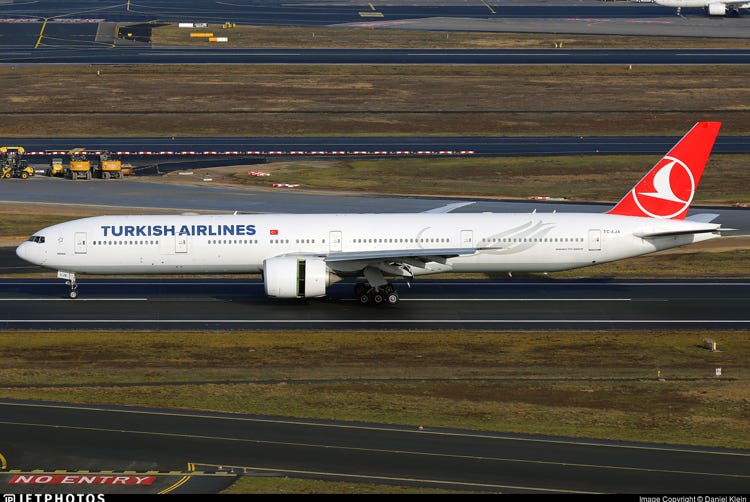

Slănic, and leaving

Distance travelled = 214 kilometres driving by road, 4 kilometres by minibus, 10.8 kilometres walking (14,430 steps) and 9,107 kilometres flying.
I think this was my longest day of staying awake on this trip. I woke to my alarm at 5:15am because I had two work-related Zoom calls scheduled before breakfast in order to fit in with differences in international time zones. It was 4:15am the next day before I settled down to sleep, but more about that later.
My main destination for today was the lovely little town of Slănic, located about 100 kilometres north of Bucharest. My specific purpose in visiting Slănic was to explore the old salt mine. Salt has been mined in Slănic since at least 1532, and during Romania’s Communist era labour was provided by prisoners as well as workers.
The mine still operates, but of course visitors are not permitted into the active mining area. The area that is open to visitors has been landscaped (if that is the right word for beautifying an area that is 208 metres below the surface) into 14 trapezoid chambers at two levels with heights up to 54 metres to create sanitoria for the treatment of pulmonary diseases in the saline microclimate. There are also artistic displays and even children’s playgrounds.
I left my hotel at about 9:15am and tackled Bucharest’s horrendous traffic, breathing a sigh of relief as I reached the relative calm of countryside roads. I arrived in Slănic at a little before 11:00am, parked my car and bought my entry ticket to the salt mine (35 lei, about $10.50 Aust., being the discounted senior price – usual price being 50 lei).
Somewhat misleadingly, the car park and entry gate are not situated at the mine. Minibuses are used to transport visitors into the mine, which is located about a kilometre to the south. The minibuses only leave every half hour (on the quarter and three-quarters of the hour), so I had a wait of about 15 minutes, after which the drive downwards down to the open section of the mine took a further 15 minutes.
The wait was worth it, though, because the open areas of the mine were spectacular for their size and unusual geometric shapes. The temperature underground is a constant 13°C, which was quite a contrast from the temperature at the surface in the mid-twenties.
I had no trouble maintaining interest underground for an hour and a quarter before taking the 15-minute minibus trip up to the surface again. Before leaving Slănic I walked around the town centre for a while (it didn’t take long!), really appreciating the calmness and beauty of the place.
My drive back to Bucharest was slow as there were several traffic accidents causing long queues on the way, and I reached my hotel at about 3:30pm. I had arranged for an extended late checkout until 6:00pm, thinking I might get back in time from Slănic to fit in a short sleep before leaving to catch my 10:00pm flight. However, there wasn’t really enough time for that after the various delays during the visit to Slănic – although the opportunity to slow down and have a shower before the long flights ahead of me was certainly welcome.
I checked out of the hotel a few minutes before 6:00pm and started the arduous task of engaging with Bucharest’s traffic for the final time. The 12-kilometre drive to the off-airport car park where rental cars need to be returned was not a long one but it did include one of the city’s more complex roundabouts plus the major road leading north out of city at the height of rush hour. Thankfully the journey took only about 20 minutes and the car was returned as intact as it had been when I received it almost three weeks earlier – albeit not quite as clean.
Bucharest’s Henri Coandă Airport was bathed in a lovely golden glow by the afternoon sun when I arrived to check in for my flight. Although the check-in desks for flights don’t open until two hours before the departure time of flights from this airport, it is possible to check in early using machines, and I am travelling with hand luggage only, I was able to pass through security and immigration by 7:00pm. Compared with many airports, Bucharest is a hectic, over-crowded, somewhat chaotic place, but after the city’s roads it almost seemed like a haven of tranquillity.
My journey to Singapore involved two flights. The first was a short 425-kilometre trip to Istanbul on a Turkish Airlines Airbus A330-300 (registration TC-JNK). Scheduled to depart at 10:00pm and land in Istanbul at 11:20pm, the incoming flight arrived half an hour late, delaying our departure until 10:30pm and arrival to 11:45pm.
There was a very large group of Hasidic (ultra-Orthodox) Jewish men on my flight, immediately obvious at the boarding gate because of their distinctive style of dress. One of the Hasidic Jews sat next to me, and after he interrupted his daily Talmud lesson on his iPhone soon after sitting down, we spent the entire flight talking. His name was Chad; originally from California he is now living in Israel.
I learned that the Orthodox Jews on the flight were part of an annual pilgrimage to Uman in central Ukraine that occurs every Jewish New Year (Rosh Hashanah), and they were now returning to their various home countries. He told me that about 25,000 had attended this year’s pilgrimage, and that there had been no sense of insecurity in that part of the country despite the war raging further to the east.
The annual pilgrimage gathers in Uman because it is the birthplace of the founder of the Breslov Hasidic movement, Rabbi Nachman (1772-1810). It was a truly fascinating conversation as we exchanged views about a wide range of philosophical and theological issues, starting with my question “why aren’t any women part of the pilgrimage?”, and moving through areas such as free will, predestination, how many Eves God created, whether or not Adam had sex with animals, hallucinogenic drugs, the 613 commands, conspiracy theories (especially whether or not COVID-19 is an example of one), media manipulation, and of course the Breslov Hasidic movement.
The second flight from Istanbul to Singapore was much longer, having a Great Circle distance of 8,680 kilometres. This flight was also on Turkish Airlines, a Boeing 777-300 (registration TC-LJA). My flight was scheduled to depart at 1:45am (on 29th September), and it pushed back just six minutes late at 1:51am. The main meal for the ten-hour flight was served after take-off rather than before landing, which explains why it was about 4:15am when I finally settled down to get some sleep, making this a 23-hour awake day.
I managed to get almost five hours of disturbed sleep on the flight. Despite the overall lack of sleep over the previous day and a half, I was wide awake and thrilled to see my Singapore-based daughter-in-law and three grandchildren running to greet me as I exited Singapore’s Changi Airport. It was already late afternoon on Thursday 29th September, and I was ready for a couple of days of good quality family time.
The two final photos in today’s diary are reproduced courtesy of jetphotos.com.

